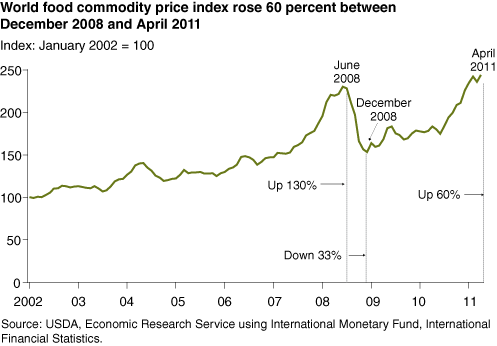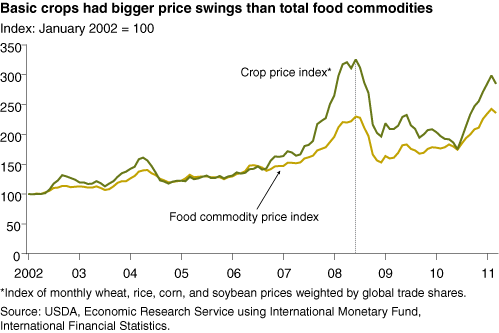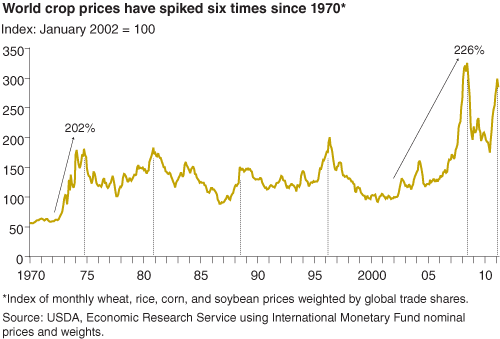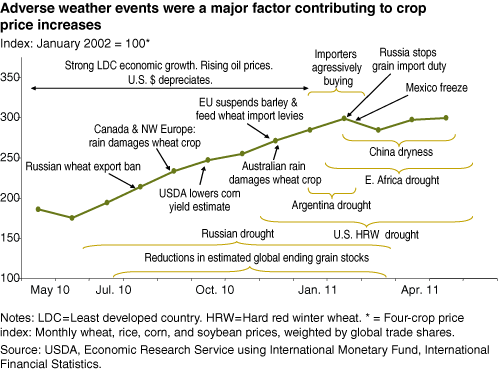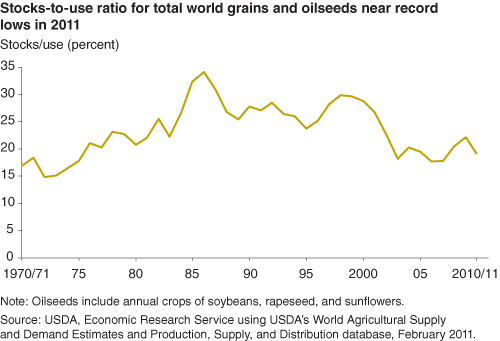Why Another Food Commodity Price Spike?
- by Ronald Trostle
- 9/1/2011
Highlights
- Large and rapid increases have occurred for many food commodity prices during 2010-11.
- Long-term production and consumption trends underlay rising food commodity prices, but worldwide production shortfalls and changes in trade policies and practices in a number of countries sparked the sharp surge in prices after June 2010.
- Many of the long-term trends and short-run shocks contributing to the current price surge also played a role in previous price spikes.
With the 2008 food commodity price spike still on the minds of consumers, livestock producers, agribusinesses, and governments, prices began increasing again in January 2009, and by February 2011, many food commodity prices had climbed above 2008 peaks. Sharp increases in agricultural prices are not uncommon, but it is rare for two price spikes to occur within 3 years.
The short period between the last two price surges raises concerns and questions. Higher food commodity prices increased food insecurity among lower income consumers and in food-deficit countries. What are the causes of the increase in world agricultural prices and what are the prospects for future price movements? Will the current period of high prices end with a sharp reversal as in previous price spikes, or have there been fundamental changes in global agricultural supply and demand relationships that may bring about a different outcome?
A Decade of Large Price Swings
In 2002, world food commodity prices began increasing, reversing a 20-year downward trend. In early 2007, price increases accelerated, and by June 2008, the monthly food commodity price index compiled by the International Monetary Fund was up 130 percent from January 2002. Over the following 6 months, the index dropped by a third.
A similar price pattern emerged in early 2009 when the food commodity price index slowly began to climb. After June 2010, prices shot up, and by January 2011, the index exceeded the previous 2008 price peak. By April 2011, the monthly index had risen 60 percent over the preceding 2 years. Although there have been wide swings in food commodity prices in the past, they usually occurred 6-8 years apart.
For four basic crops (wheat, rice, corn, and soybeans), however, price fluctuations were greater than for the total food commodity index. Between January 2002 and June 2008, an index of monthly-average world prices for these crops rose 226 percent, compared with 130 percent for the overall food commodity index. During the next 6 months, the four-crop index declined 40 percent, while the food commodity index fell 33 percent. By June 2010, the four-crop index had fallen another 11 percent, while the food commodity index rose. During this latter period of December 2008 to June 2010, lower prices for the four crops were offset by increasing prices for sugar, vegetable oils, meats, and other commodities.
Between June 2010 and March 2011, the four-crop index rose 70 percent, compared with 39 percent for the food commodity index. Bread-quality wheat, corn, sugar, and vegetable oils saw the largest price increases. Rice prices rose very little, whereas in 2007-08, rice prices rose more than prices for any other commodity.
Nonagricultural prices increased even more than food commodity prices. Energy, metals, beverages, and agricultural raw materials prices rose during 2002-08 and then declined sharply after peaking in mid-2008. Since the low points, prices for these nonfood commodities have risen more than the food commodity index, and all commodities but crude oil surpassed their 2008 peaks. The simultaneous swings in agricultural and nonagricultural prices suggest that global, economy-wide factors contributed to the surge in prices in both periods.
The 2010-11 Price Surge: Sixth Spike in Four Decades
While the current price surge is still evolving, in each of the first five price spikes since 1970, large increases in agricultural prices were followed by sharp declines. Sometimes, prices rose to record highs before dropping. Usually, prices fell as much as they had risen after the conditions that prompted the increase were reversed. In the 1975 and 2008 spikes, prices only declined to a new plateau above historical average levels.
Most price spikes resulted from unusually large changes in supply and/or demand. In some cases, unexpected production shortfalls reduced available supplies; in others, production simply stagnated while demand rose. Based on the five historical price spikes, prices rose more than typical variations until supply and demand adjusted and prices subsequently declined. It may have taken several months or several years for the markets to adjust, but eventually they did so. Historical patterns suggest that the current surge in prices will also eventually reverse directions.
A number of common factors contributed to each of the six price spikes. The relative importance of each factor, however, as well as the magnitude and duration of price movements, generally differed.
Longer Term Trends Create Conditions for a Price Spike
A number of long-term trends in agricultural production and consumption laid the groundwork for a gradual upward trend in food commodity prices between 2002 and 2006, setting the stage for the sharp 2007-08 spike. Most of these same long-term factors underlie the 2010-11 price surge, including global population and per capita income growth, declining value of the U.S. dollar, increasing world per capita consumption of animal products, slower growth in world crop yields, rising energy prices, and growing global biofuel production.
Over the past decade, the world's population increased by more than 77 million people a year. A large portion of this increase occurred in developing countries, which also have seen a rapid growth in per capita incomes. As their incomes increase, consumers in developing countries increase per capita consumption of staple foods and diversify their diets to include more meats and dairy products, increasing the demand for grains and oilseeds used for feed.
The U.S. dollar's depreciation in 2002-08 facilitated growth in U.S. exports and put upward pressure on world commodity prices. Then, the dollar's appreciation, combined with the world economic recession, coincided with declining world prices in 2008-09, followed by renewed depreciation, economic growth, and rising prices after 2009.
The increase in biofuel production--ethanol in the United States and Brazil and biodiesel production in the EU, Argentina, and Brazil--has played a role in raising prices for corn, sugar, rapeseeds, and soybeans, as well as for other crops. Attributing most of the 2002-08 rise in food commodity prices to biofuel production, however, seems unrealistic. Crop prices dropped more than 30 percent during the last half of 2008, even though biofuel production continued to increase. Further, nonagricultural prices rose more than agricultural prices, and the price of corn (an ethanol feedstock) rose less than the prices of rice and wheat (not biofuel feedstocks).
Growth in global biofuel production has slowed considerably from rates exceeding 30 percent per year in 2005-08. Nevertheless, production continues to increase, and the shares of grain used for ethanol and vegetable oils used for biodiesel, relative to total use, continue to climb. While the expansion of biofuels was an important factor underlying the general rise of food commodity prices in 2002-08 and their movement to a higher plane, it is less clear how much impact biofuels production have had in the 2010-11 surge in prices.
Short-Term Shocks Exacerbate Already Tight World Market Conditions
Probably the most significant factor contributing to the increase in staple food prices in 2010 and 2011 was a series of adverse weather events. A severe drought in Russia and parts of Ukraine and Kazakhstan reduced production of all 2010 crops, particularly wheat. In late summer 2010, dryness and high temperatures during the grain- filling period reduced yield prospects for U.S. corn. About the same time, rain on nearly mature wheat crops in Canada and northwestern Europe reduced the quality of much of the crop to feed grade.
Adverse weather conditions continued, threatening 2011 production. Drought in Russia significantly reduced winter wheat plantings for the 2011 crop. In November 2010, drought and high temperatures associated with a La Niña weather pattern spread across Argentina, reducing prospects for corn and soybean crops. Dry fall, winter, and spring weather for the U.S. hard red winter wheat crop lowered 2011 production expectations in the southwestern Great Plains. Additionally, rains in Australia in late 2010/early 2011 downgraded much of eastern Australia's wheat crop to feed quality, further reducing global supplies of food-quality wheat. In early February 2011, a rare freeze destroyed some of Mexico's standing corn crop. Heavy and persistent spring rains in the U.S. Corn Belt and the Northern Plains in the United States and Canada delayed planting of 2011 corn and wheat crops, reducing expected production. By April 2011, estimated global aggregate grain and oilseed stocks had fallen and the stocks-to-use ratio was almost down to the 2007-08 level and close to the 40-year low.
ERS has found that the ratio of global ending stocks to total use can be a reliable indicator of market prices (the lower the ratio, the tighter the market and the higher the price.) Currently, the stocks-to-use ratios for corn and soybeans are near record lows. The stocks-to-use ratios for wheat and rice suggest reasonably comfortable stock levels, but the shortage of milling-quality wheat has put strong upward pressure on wheat prices. Stock-to-use ratios for cotton, total oilseeds, total coarse grains, and sugar are also low. These low ratios suggest strong worldwide competition among crops for acreage in the 2011 planting season.
Meat prices, which did not contribute to higher 2002-08 food prices, did play a role in the recent increase. When feed costs increased in 2002-08, livestock producers responded by slowing production. As world economic growth rebounded in 2009 and 2010, consumers demanded more meat and prices began to rise. Beef and pork production could not respond in the short run because of multiyear cattle and hog production cycles. Thus, meat prices began to increase nearly a year before crop prices renewed their upward trend.
Just as in 2008, a number of countries imposed export restrictions or relaxed import controls in an attempt to shield their consumers from higher world food commodity prices. In August 2010, Russia imposed a wheat export ban after realizing the extent of its wheat shortfall. Some countries also restricted crop exports. A number of importing countries reduced or suspended import tariffs. A few countries increased subsidies to reduce consumers' food costs. By restricting or relaxing controls, countries reduced exportable supplies and increased import demand at a time when world markets were already tightening because of production shortfalls and expanded demand arising from renewed income growth.
In late 2010, after world stocks of food commodities declined and prices increased, some importers began to contract aggressively for additional imports--first for wheat, then later for other food commodities. Countries that usually import sufficient quantities of grain to meet their needs for 2-3 months began to contract with suppliers for imports to meet their needs for 4-6 months.
Impacts of High Food Prices Are Extensive
Rising food prices can cause food insecurity rates to rise. Higher prices tend to negatively affect lower income consumers more than those with higher incomes. Lower income consumers spend a larger share of their income on food, and staple food commodities, such as corn, wheat, rice, and vegetable oils, account for a larger share of food expenditures for low-income families. Consumers in some low-income, food-deficit countries also tend to rely on imported food, usually purchased at higher world prices, making them more vulnerable to rising world prices. Compounding the situation, food aid donations shrink as prices increase because donors' fixed budgets purchase smaller quantities. Government trade and domestic food policies can affect how much of an increase in world prices gets passed on to consumers.
This time, however, the short-term impact of higher 2010-11 prices on food-deficit, developing countries may be limited. Some countries in Sub-Saharan Africa, such as Nigeria and Ethiopia, harvested large crops in 2010 and actually have more domestically produced food available than they did in 2008. As a result, local prices have remained low. Also, imports contribute a small share of overall food supplies for many of these countries, so factors affecting domestic production, such as weather, play a more critical role in food security. There is little price transmission from the international market to many of these local markets, as a result of limited integration into global markets, poor market infrastructure, and subsidies provided by these governments.
The 2007-08 price spike gave rise to public demonstrations in several dozen countries protesting the higher cost of food. Many were peaceful, some were violent. Public protests and demonstrations in at least a half dozen countries can be indirectly associated with rising food prices.
Where Will Prices Go?
Periods of rising and falling prices for agricultural products are not uncommon. Historically, during each price spike period, rising commodity prices constrained demand and increased production, which in turn, led to declining prices.
High 2011 crop prices are expected to stimulate increased plantings and more intensive use of other production inputs. Farmers around the world will have incentives to increase area planted to all crops, and assuming average weather over the next year or so, world food production would be expected to increase. High prices will also limit grain and oilseed use by consumers, livestock producers, and industrial users.
On balance, higher production and lower use would raise global stocks of grains and oilseeds. Prices would be expected to peak and then to begin to decline, following the historical pattern of price movements. How quickly and how far prices fall will depend on many factors, including weather and its impact on production and stocks and future changes in trade policies and practices.
This article is drawn from:
- Trostle, R., Marti, D., Rosen, S. & Westcott, P. (2011). Why Have Food Commodity Prices Risen Again?. U.S. Department of Agriculture, Economic Research Service. WRS-1103.
- Trostle, R. (2008). Global Agricultural Supply and Demand: Factors Contributing to the Recent Increase in Food Commodity Prices. U.S. Department of Agriculture, Economic Research Service. WRS-0801.


